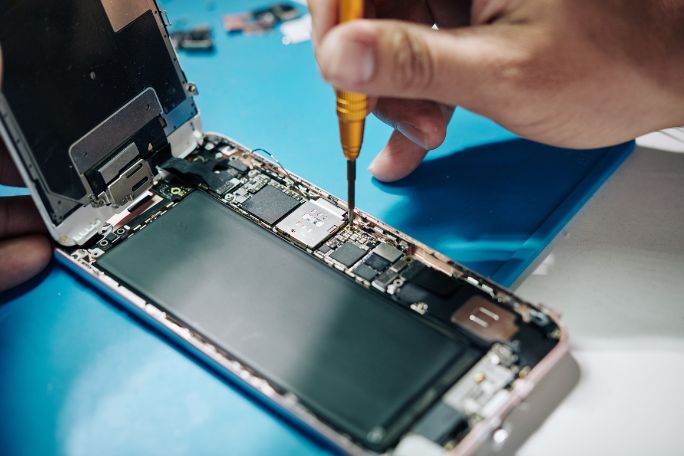Lesson summary
Students explore e-waste, planned obsolescence, and the right to repair. They conduct research into an electronic product and write a letter to the company that makes this product to find out more about it.
Learning intentions:
Students will...
- understand the impacts of e-waste
- recognise the consequences of planned obsolescence
- recognise that repairing products instead of upgrading them would positively contribute to a more sustainable future.
Success criteria:
Students can...
- explain planned obsolescence and right to repair
- draft and create a letter to send to companies
- think critically about the electronic products they use.
Lesson guides and printables
Lesson details
Curriculum mapping
Australian Curriculum content descriptions:
Year 7 Economics and Business:
- The ways consumers and producers interact and respond to each other in the market (ACHEK017).
- Develop questions about an economic or business issue or event, and plan and conduct an investigation or project (ACHES021).
- Gather relevant data and information from a range of digital, online and print sources (ACHES022).
Year 8 Economics and Business:
- The ways markets in Australia operate to enable the distribution of resources, and why they may be influenced by government (ACHEK027).
- Develop questions about an economic or business issue or event, and plan and conduct an investigation or project (ACHES032).
- Gather relevant data and information from a range of digital, online and print sources (ACHES033).
Year 9 Economics and Business:
- The changing roles and responsibilities of participants in the Australian or global workplace (ACHEK042).
- Develop questions and hypotheses about an economic or business issue or event, and plan and conduct an investigation (ACHES043).
- Gather relevant and reliable data and information from a range of digital, online and print sources (ACHES044).
Syllabus outcomes: C4.2, C4.3, C4.4, C4.7, C4.9, C5.2, C5.3, C5.4, C5.7, C5.9.
General capabilities: Critical and Creative Thinking, Literacy.
Cross-curriculum priority: Sustainability OI.7, OI.9.
Relevant parts of Year 7 Economics and Business achievement standards: Students describe the interdependence of consumers and producers in the market. When researching, students develop questions and gather data and information from different sources to investigate an economic or business issue.
Relevant parts of Year 8 Economics and Business achievement standards: Students explain how markets operate and recognise why governments may influence the market’s operation. When researching, students develop questions and gather relevant data and information from different sources to investigate an economic or business issue.
Relevant parts of Year 9 Economics and Business achievement standards: Students explain the role of the Australian economy in allocating and distributing resources. When researching, students develop questions and simple hypotheses to frame an investigation of an economic or business issue. They gather and analyse relevant data and information from different sources to answer questions.
This lesson is part of the wider unit of work Clean Up Australia – Secondary Curriculum.
Time required: 60+ mins.
Level of teacher scaffolding: Medium – lead students in class discussion, oversee letter drafting before sending.
Resources required
- Devices with internet access
- Generating Great Questions Factsheet
- Letter Writing Tips
- Planned Obsolescence Article
- Right To Repair Article
- Student Worksheet – one copy per student.
Skills
This lesson is designed to build students’ competencies in the following skills:
- Communication
- Community engagement
- Critical thinking
- Problem solving
- Collaboration
Additional info
Following this lesson plan is an ideal way for your school to take part in Schools Clean Up Day or a Clean Up on any day of the year. You’ll be joining thousands of amazing teachers in making a difference and creating positive environmental change.


Welcome back!
Don't have an account yet?
Log in with:
By signing up to Cool.org you consent and agree to Cool's privacy policy to
store, manage and process your personal information. To read more, please see
our privacy policy here(Opens in new tab).
Create your free Cool.org account.
Many of our resources are free, with an option to upgrade to Cool+ for premium content.
Already have an account?
Sign up with:
By signing up to Cool.org you consent and agree to Cool's privacy policy to
store, manage and process your personal information. To read more, please see
our privacy policy here(Opens in new tab).